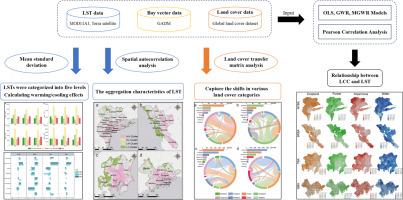揭示土地覆被变化对全球主要海湾地区地表温度的动态影响
IF 7.1
1区 工程技术
Q1 CONSTRUCTION & BUILDING TECHNOLOGY
引用次数: 0
摘要
关于城市热岛(UHI)的跨国比较研究,尤其是全球重要海湾地区城市群在不同城市化水平下的比较分析,尚属空白。目前,世界各地的海湾地区正处于不同的城市化阶段,城市土地覆盖向热环境的转变也大不相同。本研究调查了 2000 年至 2020 年四个主要湾区(包括旧金山湾区、纽约湾区、东京湾区和粤港澳大湾区)的土地覆被变化(LCC)和地表温度(LST)的时空变化。利用相关性分析和多尺度地理加权回归模型(MGWR),目的是了解 LCC 对区域热环境的影响。研究结果表明(1) 土地覆被的主要变化是森林和耕地面积减少,不透水地表增加,而森林砍伐和农业转化是造成不透水地表增加的主要因素。在此期间,全球生物圈保护区的不透水地面大幅增加了 112%。(2) 低地温度带趋向于较高的中等低地温度带,这与城市不透水面积的扩大密切相关。(3)MGWR 模型强调了土地覆被变化与 LST 影响之间的直接非平稳关系。该模型显示,不透水地表的转换,特别是水域和耕地的转换,明显加剧了 LST,而水体和森林则显示出缓解 LST 的巨大能力。建议城市规划者减缓因林地和水环境转变为不透水区域而导致的 LST 升高,这一变化在高度城市化地区尤为普遍。这项研究为平衡城市热环境管理和城市化进程提供了宝贵的视角。本文章由计算机程序翻译,如有差异,请以英文原文为准。

Revealing the dynamic effects of land cover change on land surface temperature in global major bay areas
Comparative studies across national boundaries on urban heat islands (UHI) are lacking, especially comparative analyses among globally important bay area urban agglomerations at different levels of urbanizations. Bay areas around the world are currently experiencing different stages of urbanization, and the transformation of urban land cover into thermal environments varies significantly. This study investigated the spatial-temporal changes of land cover change (LCC) and the land surface temperature (LST) in four major bay areas (including the San Francisco Bay Area (SFBA), the New York Bay Area (NYBA), the Tokyo Bay Area (TBA), and the Guangdong-Hong Kong-Macao Bay Area (GBA)) from 2000 to 2020. Utilizing correlation analysis and the multiscale geographical weighted regression model (MGWR), the goal was to understand how LCC impact the thermal environmental regionally. The results showed that: (1) The main shift in land cover involved a decrease in forested and cultivated area and an increase in impervious surfaces, with deforestation and agriculture conversion being major factors in this increase. The GBA gave a significant 112% rise in impervious surface during this period. (2) The LST trended towards higher, medium LST zones, closely linked with urban impervious surface expansion. (3) The MGWR model highlighted the direct non-stationary relationship between land cover alterations and LST effects. It showed that conversion to impervious surfaces, particularly from water and cultivated lands, markedly intensified LST, whereas water bodies and forests demonstrated a substantial capacity to mitigate LST. Urban planners were advised to mitigate LST elevations stemming from the transformation of forest lands and aquatic environments into impervious areas, a change notably prevalent in highly urbanized regions. This study provides valuable perspectives on balancing the management of urban thermal environments and urbanization processes.
求助全文
通过发布文献求助,成功后即可免费获取论文全文。
去求助
来源期刊

Building and Environment
工程技术-工程:环境
CiteScore
12.50
自引率
23.00%
发文量
1130
审稿时长
27 days
期刊介绍:
Building and Environment, an international journal, is dedicated to publishing original research papers, comprehensive review articles, editorials, and short communications in the fields of building science, urban physics, and human interaction with the indoor and outdoor built environment. The journal emphasizes innovative technologies and knowledge verified through measurement and analysis. It covers environmental performance across various spatial scales, from cities and communities to buildings and systems, fostering collaborative, multi-disciplinary research with broader significance.
 求助内容:
求助内容: 应助结果提醒方式:
应助结果提醒方式:


